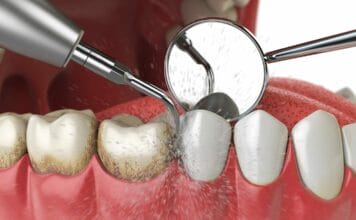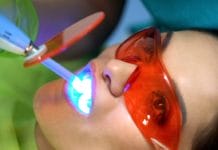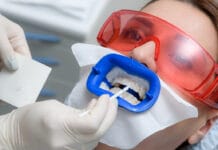1. When using a handheld X-ray device, the operator is not exposed to leakage or scattering radiation when they are located behind the focal spot plane and use the device according to the manufacturer’s instructions.
A study aiming to evaluate radiation safety and dose values when using a handheld X-ray device in a dental setting found that operators are not exposed to leakage or scattering radiation when they are located behind the focal spot plane and use the device according to the manufacturer’s instructions. This effectively addresses one of the major safety concerns associated with handheld X-ray devices.
Rottke, D., Gohlke, L., Schrödel, R., et al. Operator Safety during the Acquisition of Intraoral Images with a Handheld and Portable X-ray Device. Dento Maxillo Facial Radiology. 2018; 47(3): 20160410. https://doi.org/10.1259/dmfr.20160410
2. Radiographs should only be taken in the second trimester of pregnancy. When taking radiographs on a pregnant patient, two layers of lead aprons are necessary to protect the fetus.
There is a lot of misunderstanding and misconception regarding acquiring radiographs during pregnancy among clinicians as well as patients. Radiographs can safely be acquired during any trimester.1 Though some states require it by law, lead shielding is not required when acquiring radiographs on pregnant patients. Lead shielding provides no extra protection to the patient or the fetus.2
1. Bahanan, L., Tehsin, A., Mousa, R., et al. Women’s Awareness Regarding the Use of Dental Imaging during Pregnancy. BMC Oral Health. 2021; 21(1): 357. https://doi.org/10.1186/s12903-021-01726-6
2. Benavides, E., Bhula, A., Gohel, A., et al. Patient Shielding during Dentomaxillofacial Radiography: Recommendations from the American Academy of Oral and Maxillofacial Radiology. Journal of the American Dental Association. 2023; 154(9): 826-835.e2. https://doi.org/10.1016/j.adaj.2023.06.015
3. All of the following are ways to reduce radiation exposure in a dental setting except:
For many years, lead shielding was believed to lower the dose of radiation the patient is exposed to in a dental setting. New research indicates that lead shielding does not reduce radiation exposure. There is more reduction in radiation exposure when digital technology and collimation are implemented versus the use of lead shielding. Lead shielding does not reduce internal scatter radiation, rendering it useless in reducing radiation exposure.
Benavides, E., Bhula, A., Gohel, A., et al. Patient Shielding during Dentomaxillofacial Radiography: Recommendations from the American Academy of Oral and Maxillofacial Radiology. Journal of the American Dental Association. 2023; 154(9): 826-835.e2. https://doi.org/10.1016/j.adaj.2023.06.015
4. Pregnant dental clinicians can safely continue taking radiographs due to the low doses used. Modifications are usually unnecessary in dental settings to prevent fetal doses exceeding 1 mSv.
It is very rare for pregnant clinicians to receive a fetal dose of more than 1 mSv from capturing dental radiographs. For this reason, modifications are not necessary to reduce the dose received as the dose is already well below the threshold that would cause fetal harm. Nonetheless, if the clinician is concerned, the clinician can use protective measures, such as personal lead shielding, as well as exposure monitoring with a dosimeter badge.1
The threshold dose for a fetus for prenatal death, microcephaly, and growth restriction is 100 mSv. The threshold dose for intellectual disabilities is 300 mSv, making the 1 mSv received via prenatal radiation exposure of a clinician negligible.2
1. Radiation Protection of Staff in Dental Radiology. (n.d.). International Atomic Energy Agency. https://www.iaea.org/resources/rpop/health-professionals/dentistry/staff
2. Benavides, E., Bhula, A., Gohel, A., et al. Patient Shielding during Dentomaxillofacial Radiography: Recommendations from the American Academy of Oral and Maxillofacial Radiology. Journal of the American Dental Association. 2023; 154(9): 826-835.e2. https://doi.org/10.1016/j.adaj.2023.06.015
5. In the U.S., the mean dose of radiation received by dental workers per year is:
On average, the mean radiation dose dental workers receive per year in the U.S. is 0.2 mSv. This is the equivalent of receiving two bitewing radiographs.1,2 When compared to the average background radiation received annually, 6.2 mSv, the dose received from working in a dental setting is negligible.3
1. Radiation Protection of Staff in Dental Radiology. (n.d.). International Atomic Energy Agency. https://www.iaea.org/resources/rpop/health-professionals/dentistry/staff
2. Benavides, E., Bhula, A., Gohel, A., et al. Patient Shielding during Dentomaxillofacial Radiography: Recommendations from the American Academy of Oral and Maxillofacial Radiology. Journal of the American Dental Association. 2023; 154(9): 826-835.e2. https://doi.org/10.1016/j.adaj.2023.06.015
3. Doses in Our Daily Lives. (2022, April 26). United States Nuclear Regulatory Commission. https://www.nrc.gov/about-nrc/radiation/around-us/doses-daily-lives.html
6. When acquiring dental radiographs, breast tissue receives the same absorbed dose whether the patient is shielded or not.
Absorbed radiation dose to the breast tissue is the same with or without lead shielding. Lead shielding does not protect tissues and organs from scatter radiation, which is the primary source for absorbed dose in breast tissue from dental radiographs.
Procedure and absorbed dose:
- Intraoral radiograph
- Unshielded < 0.1
- Shielded < 0.1 - Panoramic radiograph
- Unshielded < 0.1
- Shielded < 0.1 - Cephalometric radiograph
- Unshielded < 0.1
- Shielded < 0.1 - Cone-beam CT
- Unshielded < 0.1
- Shielded < 0.1
Benavides, E., Bhula, A., Gohel, A., et al. Patient Shielding during Dentomaxillofacial Radiography: Recommendations from the American Academy of Oral and Maxillofacial Radiology. Journal of the American Dental Association. 2023; 154(9): 826-835.e2. https://doi.org/10.1016/j.adaj.2023.06.015
7. The linear no-threshold model applied to radiation is based on high doses of radiation from atomic bombs. Evidence shows a dose-response relationship for low-dose radiation (below 100 mSv) is typically nonlinear.
Current standards and practices are based on the premise that any radiation dose could result in detrimental health effects. This is based on high doses of radiation from incidents such as the bombing of Hiroshima and Nagasaki. New evidence has emerged that indicates a dose-response relationship that is typically nonlinear with radiation doses below 100 mSv.1
These studies are paving the way to improve standards and practices, which may change over time. A current example is the change in the recommendations regarding lead shielding.2 Though the recommendations regarding lead shielding have changed, it is imperative to know and follow the regulations in your state’s dental practice act and/or health authority/department of health, as some states require lead shielding.
1. Radiation Risk in Perspective: Position Statement of The Health Physics Society. (2019, February). Health Physics Society. https://hps.org/documents/radiationrisk.pdf
2. Benavides, E., Bhula, A., Gohel, A., et al. Patient Shielding during Dentomaxillofacial Radiography: Recommendations from the American Academy of Oral and Maxillofacial Radiology. Journal of the American Dental Association. 2023; 154(9): 826-835.e2. https://doi.org/10.1016/j.adaj.2023.06.015












